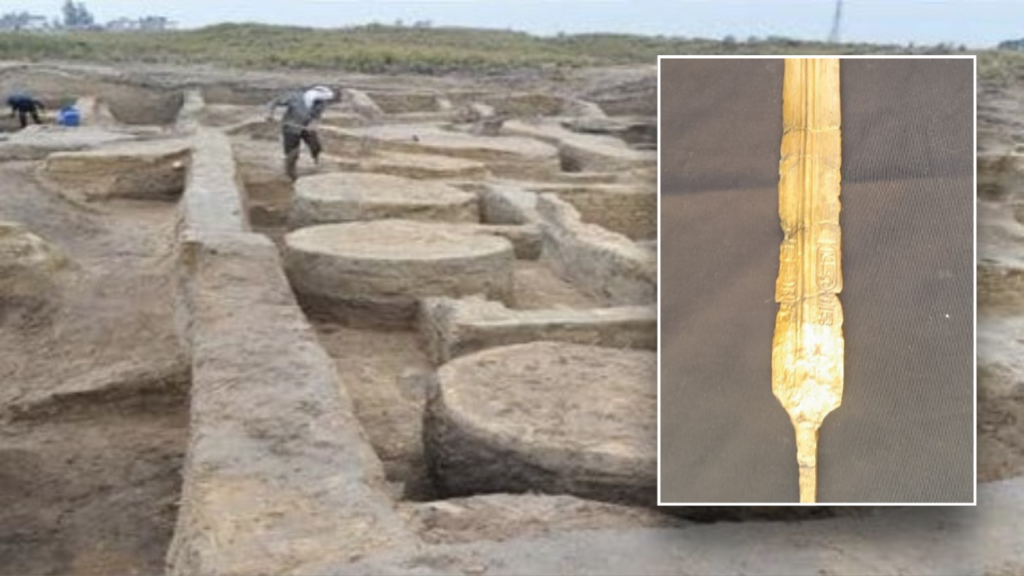Egyptian archaeologists have recently made a remarkable discovery that sheds light on a pivotal era in ancient history. According to a press release from the Egyptian Ministry of Tourism and Antiquities dated September 5, they unearthed an ancient sword associated with the military of Ramesses II, a prominent pharaoh often believed to be referenced in the biblical Book of Exodus. This significant find occurred during an excavation in Housh Eissa, a city located in the Beheira Governorate of Egypt. The site of the excavation is known as Tell Al-Abqain, which has proven to be a treasure trove of historical artifacts.
At the Tell Al-Abqain site, archaeologists uncovered a series of mudbrick architectural units, including what were identified as military barracks for soldiers. Additionally, storage rooms containing weapons, food, and vital provisions from the New Kingdom era were discovered. Among the most notable artifacts was a bronze sword inscribed with the cartouche—a hieroglyphic symbol—of Ramesses II. Despite the ravages of time that have led to some decay of the artifact, the representation of the Egyptian ruler remains discernible, offering a striking connection to the past.
The excavation has yielded more than just the sword; it has produced numerous artifacts and personal items previously belonging to the soldiers stationed at the fort. According to Egyptian officials, these findings illuminate the daily lives, religious practices, and military engagements of those inhabitants. The array of relics uncovered includes not only weapons and tools utilized in battles but also personal adornments and hygiene items, which further enrich our understanding of their cultural practices.
Among the items found were various types of weapons used in combat, hunting implements, and personal adornments, including jewelry. Some intriguing specific artifacts include ivory kohl applicators, carnelian and faience beads, scarabs, and protective amulets. Each of these items offers a glimpse into the intricate and multifaceted lives led by the soldiers of Ramesses II and serves as a testament to the artistry and craftsmanship of the time.
Ramesses II, often referred to as Ramses, was born in 1303 B.C. and is thought to have died in 1213 B.C. He ruled over Egypt during a significant period marked by extensive building projects and military conquests. Scholars widely believe that he is the pharaoh depicted in the Book of Exodus, wherein Moses leads the enslaved Israelites out of Egypt toward the Desert of Paran. While the biblical text does not explicitly mention the name of the pharaoh involved in the interactions with Moses, a consensus among historians suggests that Ramesses is likely the figure in question.
Dr. Mohamed Ismail Khaled, serving as the Secretary-General of the Supreme Council of Antiquities, emphasized the historical importance of the fort. He noted that it served as a crucial outpost, protecting Egypt’s borders from the Sea Peoples—a coalition of tribes known for their invasions during the Late Bronze Age. In the press release, Dr. Khaled highlighted the architectural ingenuity of the fort, noting that the various units are meticulously designed and arranged into two identical groups separated by a narrow passageway. This careful layout illustrates the advanced engineering capabilities of the ancient Egyptians and their ability to adapt their structures for multiple practical purposes.
The unearthing of these artifacts not only contributes significantly to our understanding of ancient Egyptian civilization but also offers a tangible connection to the narratives woven into the biblical texts. As ongoing archaeological efforts continue to unveil more about Ramesses II’s reign and the lifestyle of his soldiers, it becomes increasingly apparent that these ancient sites are invaluable resources for historical and cultural exploration.
For those interested in delving deeper into topics related to archaeology, history, and culture, further Lifestyle articles can be found at www.foxnews.com/lifestyle, where the richness of our world’s past continues to be explored and celebrated.



